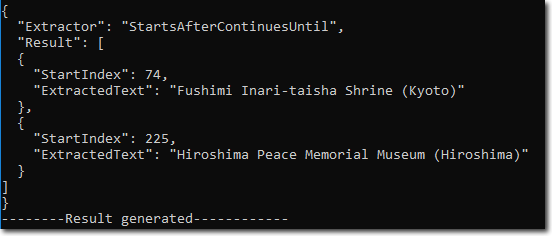Using Regular Expressions
The TextParser library provides StartsAfterContinuesUntil class to set up the StartsAfterContinuesUntil extractor which retrieves a block of text from a plain text source, based on regular expressions. It pulls all the text placed between the occurrences of starting and ending regular expression patterns.
The extraction technique using regular expressions is the simplest and the easiest to get started with, however, we must consider the following facts about this technique:
- The extractor starts from the beginning of the input text and extracts it sequentially until a match of the regular expression StartsAfter occurs. After this point, the extractor starts collecting all the text that is placed until a match of the regular expression ContinuesUntil occurs. This means that even if the extracted text contains one or more matches of StartsAfter, it will ignore the same and keep looking for the occurence of ContinuesUntil.
So, the collected text is returned as one text instance and not multiple text instances even though StartsAfter has occurred more than once in the input text.type=note
Note: For example, we have the text input as "1 Apple 2 Mangoes 3 Grapes." where we want to extract the text that StartsAfter a digit and ContinuesUntil end of the sentance using regular expressions. So, due to the sequential nature of the extractor, the output will be "Apple 2 Mangoes 3 Grapes". The extractor will count "1" as the StartsAfter condition and ignore all the other digits occuring in the text until it finds end of the sentence which is the ContinuesUntil condition.
- The StartsAfterContinuesUntil extractor is character oriented and has no concept of white space, word, or any other structural entity. It reads everything at character level.
type=note
Note: For example, we have the text intput as "An apple a day." where we want to extract the text placed between the first article and end of the sentence. Now, the extractor will not consider "An" as the first article rather it will take "A" as StartsAfter article at character level and give you the output as "n apple a day". For this reason, the regular expressions written must consider the input text as a collection of characters not words.
Let us take another example to understand how to use TextParser using regular expressions.
Following drop down section shows the text input source.
Click here to see the input
Let’s look at the latest ranking of two best tourist spots in Japan.
1. Fushimi Inari-taisha Shrine (Kyoto)
Fushimi Inari Taisha Shrine fascinates the tourists most by numerous gates.
2. Hiroshima Peace Memorial Museum (Hiroshima)
Hiroshima Peace Memorial Museum is one of top visited tourist sites.
Now, from the text input we want to retreive just the names of the tourist spots listed above. To extract any such text between StartsAfter and ContinuesUntil regular expressions using StartsAfterContinuesUntil class, you need to implement the steps mentioned in the code snippet below:
Open the plain text input stream from which you want to extract the text. csharp
Stream inputStream = File.Open("JapanTouristSpots.txt", FileMode.Open);Create an instance of the StartsAfterContinuesUntil class and pass the starting and ending regular expression patterns as parameters to it. This will initialize the StartsAfterContinuesUntil class to extract all the text between two regular expressions. csharp
StartsAfterContinuesUntil extractor = new StartsAfterContinuesUntil(@"([1-9]|10)[.]\s", "\r");The Extract method of StartsAfterContinuesUntil class is used to extract the text from input stream. This method returns an instance of IExtractionResult interface containing the extraction results. csharp
IExtractionResult res = extractor.Extract(inputStream);The ToJsonString method of the IExtractionResult interface is used to convert the extraction result to JSON string.
csharpConsole.WriteLine(res.ToJsonString());
Following image shows the parsed result in JSON string format:



